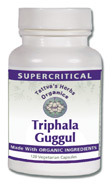 Loading... Please wait...
Loading... Please wait...Providing 25 Years Of Premium Service
Storewide Sale - Save 20%
Blog - cholesterol
Destroy Fat and Cholesterol with Guggul
Posted on 2nd Jul 2013
Guggul is a time tested Ayurvedic Herb that has proved to maintain healthy cholesterol in the body.
Guggul or guggulu (commiphora mukul, also commiphora wightii) is derived from the gummy resinous exudate of a plant closely related to myrrh that is found in arid to semi-arid areas of Northern India, Bangladesh and Pakistan. This tree has been used in Ayurvedic medicine for centuries, and Ayurvedic texts dating back to 600 BC recommend it for treatment of atherosclerosis and digestive disorders.
The Sanskrit definition of the term “guggul” is “one that protects against diseases.” This attests to the wide respect and therapeutic Ayurvedic applications for this botanical, considered to be the most important herb for the removal of “ama,” or toxic substances which accumulate as a result of sluggish digestion and circulation associated with a slowing of metabolism.
Similar to another important Ayurvedic preparation called triphala, guggul is considered tridoshic, or balancing to all three doshas in the body. The three doshas, or bodily constitutions represent the foundation of traditional Ayurveda. These are: kapha or the anabolic humour, watery humour; pitta or the catabolic, fiery humour; and vata, the air or nervous system humour. When all three humours are in balance, the result is health and wellness. When one or more are in excess or deficient this represents imbalance or disease. Guggul stimulates pitta and thus enhances warmth, digestion, circulatory and reproductive processes. It also regulates vata (nerve force) and kapha (fluidic aspects).
As an “ama”-resolving herb, guggul has a wide range of applications beginning with rheumatic and arthritic pains, lowering high cholesterol, “hardening of the arteries” (atherosclerosis), and obesity. Guggul is warming and stimulates metabolism that is why it is one of the few botanicals that has been used to treat hypothyroid conditions. In addition, it is used to treat a sluggish liver, malaria, to stimulate libido, nervous diseases, bronchial congestion, cardiac and circulatory problems, weak digestion, gynecological problems, leucorrhea, sterility, impotence, and various skin diseases including acne and psoriasis. (One of the substances contained in Guggul which is known to lower cholesterol and triglycerides is also noted for its ability to decrease the redness and swelling that occurs in some types of acne) Guggul, as with other resins, is excreted through the skin, mucus membranes and the kidneys. This is what makes it particularly useful for the urinary tract and for a wide number of skin diseases.
Guggul has been used for over 3,000 years and is described in all of the classical Ayurvedic texts including the Sushruta Samhita (3rd to 4th centuries) where it is especially recommended for the treatment of rheumatic pains and obesity, as mentioned above. It is one of the most important rasayanas (herbal tonics) of Ayurveda where it is described as warm, dry, pungent-flavored, and aromatic with nutritive, lubricant, stimulant and digestion-enhancing properties. Current research substantiates its benefit for the treatment of elevated blood lipids and coronary and arterial plaque known as atherosclerosis. As a result, today in India standardized guggul extracts are being approved for lowering elevated serum cholesterol and triglyceride levels.
Click Here for Tattva’s Herbs Guggul Co2 Extract.

Triphala Guggul – Support Weight Management & Digestion
Triphala Guggul is a classic Ayurvedic formulation that we are pleased to be able to provide to you in Supercritical (Co2) form. Both are popular herbs found primarily in India, but they have been used in the United States and Europe as well, as a natural remedy for several conditions. This premier formula combines [...]

Guggul – “One that protects against diseases.”
Guggul or guggulu (commiphora mukul, also commiphora wightii) is derived from the gummy resinous exudate of a plant closely related to myrrh that is found in arid to semi-arid areas of Northern India, Bangladesh and Pakistan. This tree has been used in Ayurvedic medicine for centuries, and Ayurvedic texts dating back to 600 BC recommend [...]















